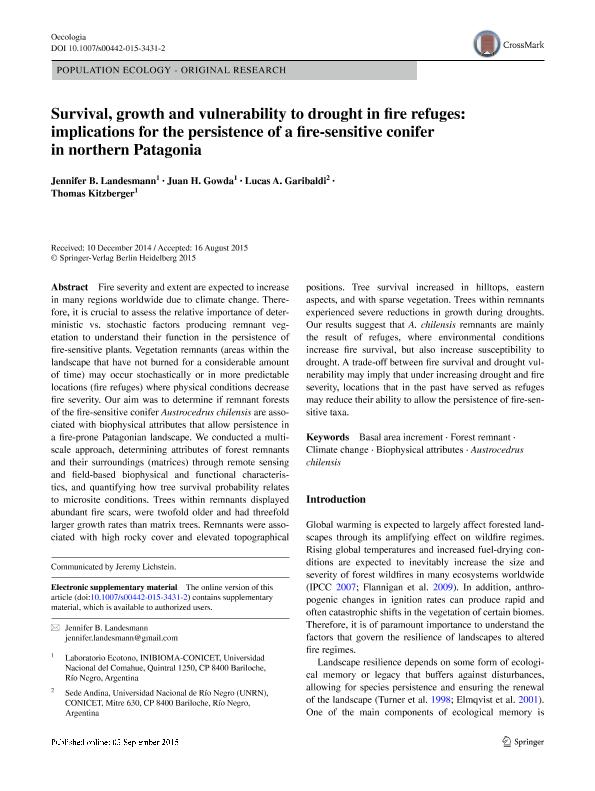Mostrar el registro sencillo del ítem
dc.contributor.author
Landesmann, Jennifer Brenda

dc.contributor.author
Gowda, Juan Janakiram Haridas

dc.contributor.author
Garibaldi, Lucas Alejandro

dc.contributor.author
Kitzberger, Thomas

dc.date.available
2018-08-10T18:33:24Z
dc.date.issued
2015-09
dc.identifier.citation
Landesmann, Jennifer Brenda; Gowda, Juan Janakiram Haridas; Garibaldi, Lucas Alejandro; Kitzberger, Thomas; Survival, growth and vulnerability to drought in fire refuges: implications for the persistence of a fire-sensitive conifer in northern Patagonia; Springer; Oecologia; 179; 4; 9-2015; 1111-1122
dc.identifier.issn
0029-8549
dc.identifier.uri
http://hdl.handle.net/11336/54984
dc.description.abstract
Fire severity and extent are expected to increase in many regions worldwide due to climate change. Therefore, it is crucial to assess the relative importance of deterministic vs. stochastic factors producing remnant vegetation to understand their function in the persistence of fire-sensitive plants. Vegetation remnants (areas within the landscape that have not burned for a considerable amount of time) may occur stochastically or in more predictable locations (fire refuges) where physical conditions decrease fire severity. Our aim was to determine if remnant forests of the fire-sensitive conifer Austrocedrus chilensis are associated with biophysical attributes that allow persistence in a fire-prone Patagonian landscape. We conducted a multi-scale approach, determining attributes of forest remnants and their surroundings (matrices) through remote sensing and field-based biophysical and functional characteristics, and quantifying how tree survival probability relates to microsite conditions. Trees within remnants displayed abundant fire scars, were twofold older and had threefold larger growth rates than matrix trees. Remnants were associated with high rocky cover and elevated topographical positions. Tree survival increased in hilltops, eastern aspects, and with sparse vegetation. Trees within remnants experienced severe reductions in growth during droughts. Our results suggest that A. chilensis remnants are mainly the result of refuges, where environmental conditions increase fire survival, but also increase susceptibility to drought. A trade-off between fire survival and drought vulnerability may imply that under increasing drought and fire severity, locations that in the past have served as refuges may reduce their ability to allow the persistence of fire-sensitive taxa.
dc.format
application/pdf
dc.language.iso
eng
dc.publisher
Springer

dc.rights
info:eu-repo/semantics/openAccess
dc.rights.uri
https://creativecommons.org/licenses/by-nc-sa/2.5/ar/
dc.subject
Austrocedrus Chilensis
dc.subject
Basal Area Increment
dc.subject
Biophysical Attributes
dc.subject
Climate Change
dc.subject
Forest Remnant
dc.subject.classification
Otras Ciencias Biológicas

dc.subject.classification
Ciencias Biológicas

dc.subject.classification
CIENCIAS NATURALES Y EXACTAS

dc.subject.classification
Agricultura

dc.subject.classification
Agricultura, Silvicultura y Pesca

dc.subject.classification
CIENCIAS AGRÍCOLAS

dc.title
Survival, growth and vulnerability to drought in fire refuges: implications for the persistence of a fire-sensitive conifer in northern Patagonia
dc.type
info:eu-repo/semantics/article
dc.type
info:ar-repo/semantics/artículo
dc.type
info:eu-repo/semantics/publishedVersion
dc.date.updated
2018-08-08T14:14:14Z
dc.identifier.eissn
1432-1939
dc.journal.volume
179
dc.journal.number
4
dc.journal.pagination
1111-1122
dc.journal.pais
Alemania

dc.journal.ciudad
Berlin
dc.description.fil
Fil: Landesmann, Jennifer Brenda. Consejo Nacional de Investigaciones Científicas y Técnicas. Centro Científico Tecnológico Conicet - Patagonia Norte. Instituto de Investigaciones en Biodiversidad y Medioambiente. Universidad Nacional del Comahue. Centro Regional Universidad Bariloche. Instituto de Investigaciones en Biodiversidad y Medioambiente; Argentina
dc.description.fil
Fil: Gowda, Juan Janakiram Haridas. Consejo Nacional de Investigaciones Científicas y Técnicas. Centro Científico Tecnológico Conicet - Patagonia Norte. Instituto de Investigaciones en Biodiversidad y Medioambiente. Universidad Nacional del Comahue. Centro Regional Universidad Bariloche. Instituto de Investigaciones en Biodiversidad y Medioambiente; Argentina
dc.description.fil
Fil: Garibaldi, Lucas Alejandro. Universidad Nacional de Rio Negro. Sede Andina; Argentina. Consejo Nacional de Investigaciones Científicas y Técnicas; Argentina
dc.description.fil
Fil: Kitzberger, Thomas. Consejo Nacional de Investigaciones Científicas y Técnicas. Centro Científico Tecnológico Conicet - Patagonia Norte. Instituto de Investigaciones en Biodiversidad y Medioambiente. Universidad Nacional del Comahue. Centro Regional Universidad Bariloche. Instituto de Investigaciones en Biodiversidad y Medioambiente; Argentina
dc.journal.title
Oecologia

dc.relation.alternativeid
info:eu-repo/semantics/altIdentifier/doi/http://dx.doi.org/10.1007/s00442-015-3431-2
dc.relation.alternativeid
info:eu-repo/semantics/altIdentifier/url/https://link.springer.com/article/10.1007%2Fs00442-015-3431-2
Archivos asociados
